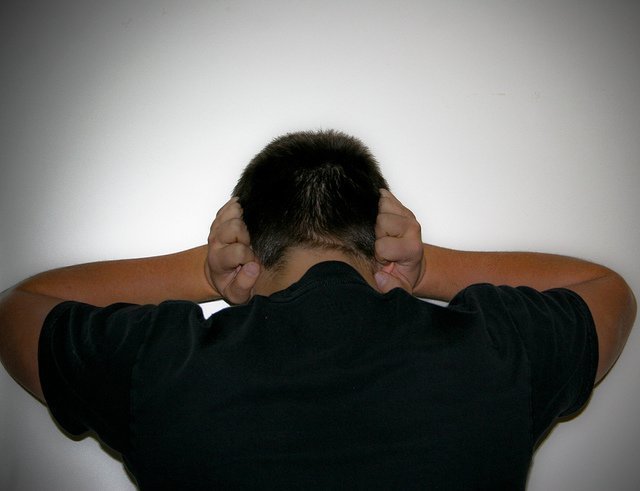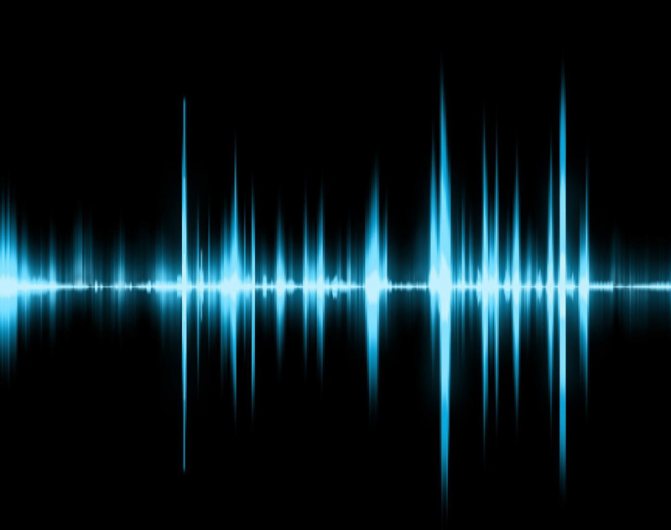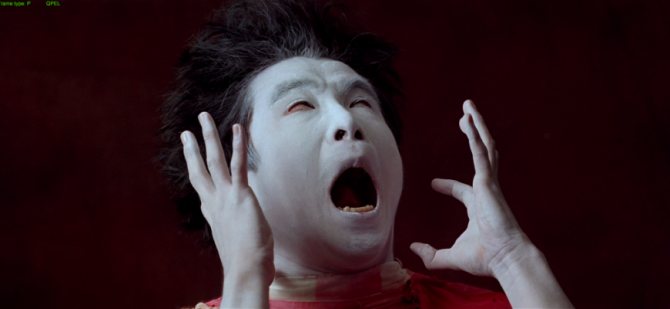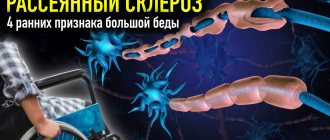Acousticophobia (synonyms: phonophobia, ligyrophobia) – fear of loud and sharp sounds.
People are surrounded by countless background noises every day, but gradually getting used to the surrounding sounds, a person stops noticing them.
Fright and flinching from an unexpected knock or pop is an innate reaction to potential danger, but uncontrollable fear and panic attacks caused by sounds that stand out from the general background may indicate that a person has acoustic phobia.
Acousticophobia is one of those phobias whose causes must be sought in early childhood, however, serious incidents accompanied by loud sounds can contribute to the development of the disorder in an adult person.
Symptoms of neurasthenia
Neurasthenia is a form of mental disorder belonging to the group of neuroses.
Symptoms of neurasthenia manifest themselves in the form of increased irritability, fatigue, and inability to undergo prolonged mental or physical stress. The main causes of neurasthenia lie, as a rule, in psychological trauma against the background of mental and physical overload , as well as other factors that weaken the body, for example, such as: infections, intoxications, problems with the thyroid gland, poor nutrition, lack of sleep, alcohol consumption , smoking and others. Thus, a balanced work and rest regime, a healthy lifestyle, and the elimination of stress and physical overload can serve as a preventive measure for neurasthenia.
The signs of neurasthenia are varied, but among them the following are the most common:
- quick change of mood,
- headache,
- sleep disorder,
- lack of attention,
- low mental activity,
- convulsions,
- indifference to everything
- noise in ears.
It is customary to distinguish three stages in the course of this disease.
Symptoms
People who are afraid of sharp sounds experience the following symptoms:
- cardiopalmus;
- increased sweating;
- dry mouth;
- pale skin;
- increased blood pressure;
- dilated pupils;
- trembling of hands and feet;
- numbness of fingers;
- dizziness;
- muscle tension;
- loss of self-control.
In severe cases of the disease, panic attack syndrome may develop. It will lead to a serious mental disorder - neurosis. Treatment is long-term, over several years.
Increased blood pressure accompanies a fear attack
Hypersthenic stage
This is the initial stage of the disease. Symptoms of neurasthenia at this stage are expressed in increased mental excitability and a pronounced nervous reaction. Anything can cause irritation: from simple noise to crowds of people. Very quickly, patients lose their state of nervous and mental balance, shout at others, and lose self-control. At this stage, a person experiences problems with concentration, they are unable to concentrate on anything, are distracted and complain of poor memory. Headaches, a feeling of heaviness in the head, and pressure in the temples are also common.
How to cure neurasthenia?
There are several approaches to this:
The maximum benefit comes from a combination of both methods of treatment: on the one hand, medical treatment, which can alleviate the patient’s suffering at a particular moment, and on the other hand, psychoanalysis, which will help to get to the bottom of the deep sources of the problem, by understanding which it will be possible to prevent subsequent occurrences of the disease.
It is necessary to treat this disease and this must be done by an appropriate specialist psychotherapist, in order to avoid the disease from flowing into more complex diseases or becoming a chronic disease. The consequences of neurasthenia usually plague people who have not received proper treatment. For example, an irritation reaction to loud noises or strong odors may persist. Depending on the characteristics of a particular individual (for example, people prone to narcissism or depression), the disease may be difficult to cure and there is a very high probability of it becoming chronic even with timely treatment.
lecheniedepressii.ru
How to get rid of phonophobia
To treat phonophobia, psychologists use:
- breathing exercises;
- auto-trainings;
- hypnotherapy;
- NLP, etc.

When the fear of loud sounds is severe, they resort to the help of psychiatrists and psychotherapists. Antidepressants, tranquilizers, and sedatives may be prescribed for treatment.
However, the methods discussed are aimed at eliminating the consequences, and not at the very cause that caused the fear. Treatment with drugs can relieve excessive anxiety and emotionality, but will not relieve fear. To cope with phonophobia, you need to understand its root. Anyone who has the knowledge gained in the “System-Vector Psychology” training by Yuri Burlan can determine the cause of the fear of loud sounds. Awareness of the peculiarities of your psyche allows you to get rid of phonophobia and many other problems.
The fear of loud sounds in visual people disappears after working through fears during training. Having realized the root of all visual fears, a person gets rid of numerous phobias. There is no trace of fear left.
Eliminating noise that annoys sound engineers will not solve the problem. After all, noise intolerance is a consequence of unfulfilled desires in the sound vector.
The training helps the sound artist discover the meaning of life that he is so eager to find and get rid of depression. Along with depression, intolerance to sounds and noise goes away. Headphones and earplugs are a thing of the past. A person gets the opportunity to enjoy the sound of this world, and not run away from it like the plague.
The results of those who completed the “System-Vector Psychology” training are impressive.
“I took off my headphones! For the first time in 17 years after my attempt to say goodbye to life, the world became interesting to me.” Marina B., Sevastopol-Moscow
“In the last year leading up to the training, my madness reached its climax. It was total insomnia. Not only could I no longer be among people, I could not be anywhere. Any sounds hurt me, I was not able to leave the house because of it. I couldn't stand any communication. I often felt the desire to strangle people, especially when they opened their mouths and began to speak, every sound hit my head like a hot poker, and I knew that I would experience pleasure if I strangled the source of these sounds. At the same time, I didn’t hear the meaning of the words, there was just a terrible noise around me, as if I had been placed near an airplane turbine and was deprived of the opportunity to escape...
I can feel and experience emotions like never before, depression, apathy and delayed life syndrome have evaporated like smoke, and now I can hardly believe that before the training it was not smoke, but a viscous jelly in which I floundered like helpless a fly stuck in it.
Many years of chronic pain and migraines, resentment and envy, and many psychosomatic problems have passed. I can still hear as well as before, but now I have become able to perceive information by ear. This ability seemed to be completely absent. Now there is not useless noise around me, but quite meaningful sounds, I listen to the speech of other people and hear what they are talking about, I hear their meanings, and this in itself brings pleasure.”
Ekaterina K. psychiatrist-narcologist, Kazan
Do you want to get rid of the fear of loud sounds, phobias, and depression? Come to the training “System-vector psychology”.
Asthenic syndrome
Asthenic syndrome (synonymous with asthenia) is a symptom complex characterized by irritability, weakness, increased fatigue and unstable mood. Asthenia is a condition in which the body seems to have lost its vitality. General asthenia occurs in many chronic diseases, such as anemia, cancer, and is probably most pronounced in diseases of the adrenal glands. Asthenia may be limited to certain organs or organ systems, as in asthenopia, characterized by severe visual fatigue, or myasthenia, in which there is a gradual increase in fatigue of the muscular system. Neurocirculatory asthenia is a clinical syndrome characterized by difficulty breathing, rapid heartbeat, shortness of breath, dizziness, and insomnia.
The term neurasthenia was once commonly used to describe a similar neurotic disorder characterized by easy fatigue, lack of motivation, and feelings of inadequacy; use of the term has largely been discontinued.
Patients with asthenia are very sensitive and impressionable, and lose their self-control over trifles. They are either grumpy, dissatisfied with everything, picky, pessimistic, or, on the contrary, optimistic and flexible. For minor reasons, tearfulness occurs, accompanied by tenderness or a feeling of resentment. With physical and mental stress, fatigue quickly sets in, and with it a feeling of dislike for the work being done and the idea that it is insurmountable. Characterized by restlessness and a feeling of inner restlessness. When tired, and often without it, unpleasant thoughts easily appear, arising involuntarily, making it difficult to think and concentrate. Combinations of irritability and weakness in asthenic syndrome are varied. In some cases, the phenomena of irritability, excitability, anxiety predominate, in others - the phenomena of exhaustion, fatigue, and tearfulness. All these symptoms are usually more pronounced in the evening. Constant sleep disorders - difficulty falling asleep, shallow sleep with an abundance of dreams, early awakening. Autonomic disorders are common - feelings of chilliness, sweating, tachycardia, vasomotor disorders. Asthenic disorders can be observed as initial manifestations of all mental illnesses. They are also found in psychopathy and neuroses. We must always remember that asthenic syndrome may be the first sign of a serious mental illness. Patients with asthenic syndrome should be referred for consultation to a psychiatrist.
Asthenic syndrome (Greek astheneia - impotence, weakness) is a state of mental weakness, expressed in increased fatigue and exhaustion, loss of the ability for prolonged mental and physical stress. Patients are characterized by so-called irritable weakness, in which excitability is combined with rapidly occurring exhaustion, and affective lability with a tendency to depression and tearfulness. Hyperesthesia is also observed - painful intolerance to loud sounds, bright light, and strong odors.
Often the first manifestations of asthenic syndrome are irritability, impatience, a combination of increased fatigue with a constant desire for activity, even during rest hours (the so-called fatigue that does not seek rest). Severe manifestations of asthenic syndrome are characterized by passivity and apathy. With asthenic syndrome, headaches, increased drowsiness or insomnia, as well as autonomic disorders may occur.
Asthenic syndrome most often occurs as a consequence of somatic diseases, including infectious diseases and intoxications. Asthenic syndrome can be observed in the initial stages of organic diseases of the brain (arteriosclerosis, cerebral syphilis, progressive paralysis, encephalitis, traumatic disease). The initial period of schizophrenia is also characterized by asthenic symptoms.
Symptoms and signs of asthenic syndrome have features depending on the underlying disease in which it is observed: with atherosclerosis, memory impairment and tearfulness are noticeably expressed; with traumatic brain injury - irritable weakness with autonomic lability; with syphilis of the brain - depression with anxiety and hypochondriasis, explosiveness, persistent headaches, sleep disorders; with progressive paralysis - depression, tearfulness, hypochondriasis, sometimes mild stupor occurs. In schizophrenia, asthenic syndrome is characterized by a combination of weakness and irritability with lethargy, decreased activity, and autism. Thus, the features of asthenic syndrome (and other symptoms combined with it) have differential diagnostic significance. Asthenic syndrome, observed in various somatic diseases and organic diseases of the brain, should be distinguished from a neurasthenic state (see Neurasthenia).
Treatment consists of eliminating the cause that caused the asthenic syndrome, as well as the use of general restoratives - glucose, vitamins, strychnine, iron supplements, as well as andaxin, meprobamate, trioxazine, small doses of insulin and chlorpromazine. Physiotherapy is also indicated.
Asthenic syndrome is a state of neuropsychic weakness of various origins, expressed in disturbances in the tone of nervous processes and characterized by their great depletion, which is reflected in the rapid onset of fatigue during any activity, the inability to endure prolonged nervous tension and a decrease in all forms of mental activity.
Asthenic syndrome of moderate severity is characterized by a symptom of irritable weakness; it consists in a combination of increased excitability under the influence of external stimuli with rapid exhaustion and attenuation of the reactions caused by these stimuli. Severe asthenic syndrome is characterized by passivity, low susceptibility to external impressions and apathy combined with depression. In addition to these main manifestations of the syndrome, patients often experience a number of disorders of the autonomic nervous system, as well as prolonged headaches and sleep disorders. Irritable weakness manifests itself as hyperesthesia - morbid sensitivity to irritations that are indifferent to people with a healthy nervous system (medium volume sounds, bright lights, objections in an argument, etc.), capricious variability of moods and affective reactions, and sometimes faint-heartedness, negative affective reactions predominate character - anxiety, irritation, dissatisfaction.
Etiology. Asthenic syndrome can be caused by various endocrine diseases - thyrotoxicosis, Addison's disease, disorders of the hormonal function of the gonads, etc.; past infections, intoxications and injuries; chronic diseases that cause constant painful irritation; organic nervous diseases; some psychoses. An intermediate position between somatic disorders and neurasthenia with corticovisceral disorders is occupied by neurocirculatory asthenia, described as a purely functional disorder. Asthenic syndromes are rarely caused by only one cause; more often they have a complex origin with a predominant role of one of the acting factors. The most important syndromes are irritable weakness, apathetic lethargy, phobic, hypochondriacal pain.
Pathogenesis. The basis of asthenic syndrome is the weakness of the cerebral cortex, caused by disturbances in its nutrition and intracellular metabolism under the influence of toxic influences, as well as disorders of blood and liquor circulation. The pathological state of nerve cells underlies the weakness and rapid exhaustion of excitatory processes and the development of protective inhibition.
Treatment of asthenia is aimed at eliminating the disease (underlying asthenic syndrome). Symptomatically, general tonics, bromide preparations and sleeping pills are prescribed.
www.medical-enc.ru
Sounds that kill
Interest in sound, or as it is also called acoustic or sonar, weapons today is greater than ever. According to experts, the possible consequences of its use against humans are in a very wide range
Sound weapons are an integral part of the new principles of warfare, the essence of which is the desire to minimize material and human losses, not to destroy the enemy, but to control him, to deprive him of the ability to conduct combat operations and, above all, to break his will to resist. In this context, these weapons can be seen as the quintessence of new principles of warfare.
Interest in sound, or as it is also called acoustic or sonar, weapons today is greater than ever. According to experts, the possible consequences of its use against humans are in a very wide range, ranging from discomfort, temporary hearing loss and even death. Sound can influence the human psyche, create fear, invisible obstacles, and plunge entire units into panic. Sound weapons can be intended for various uses - dispersing crowds (demonstrations), organizing panic, protecting objects, rescuing hostages, stopping the movement of people and vehicles.

The entire world around us is a collection of waves. Everything fluctuates, from elementary particles to galaxies. The human ear perceives a very narrow range of vibrations, but this does not mean that sounds beyond our hearing do not affect our body - they affect it even to the point of changing the structure of the body’s tissues at the molecular level.
Previously, it was believed that sound was neutral in terms of its impact on humans. There is a well-known example when, at a demonstration of the first steam engines, where there was quite good noise, the creator of the machines, White, began to reduce it. Those present asked him to leave everything as it was - they liked the noise, especially its background and monotony.
For a long time, noise was generally considered an indispensable companion to the development of technology and the success of technology. Few people expected that this phenomenon would become dangerous for the functioning of living organisms, especially since humans have some degree of auditory adaptation, which, by the way, does not protect against hearing loss and other pathological processes in the body.
The sounds that surround us, for all their apparent simplicity and commonness, are not so harmless. There was a report in the press that the elevator had been replaced in one of the houses in the southwest of Moscow. After which most residents began to experience constant headaches and sleep disturbances. It turned out that the working mechanism is the source of the unfavorable range of infrasound, and the elevator shaft, like a giant pipe, further enhances it. A similar effect is well known to volcanologists. The sound of erupting lava also generates infrasound, causing an uncontrollable feeling of fear and a desire to hide.
In 1929, a historical drama was staged at the Lyric Theater in London. The authors sought to evoke special emotions in the viewer. They shared their problems with the famous physicist Robert Wood. He suggested using an acoustic effect. The low-frequency wave of sound emitted by a giant organ pipe, inaudible to the human ear, caused a monstrous resonance at the premiere. The glass shook, the chandeliers rang, the whole building shook... The audience was gripped by horror. The panic began. The performance was disrupted.
What is sound?
Sound is called regular and periodic vibrations, and noise is a collection of sounds of varying strength and height, randomly changing over time and causing unpleasant subjective sensations. Characteristics of sound waves: frequency, length, intensity and sound pressure. The physical essence of noise consists in the mechanical vibration of particles of the medium (gas, liquid, solid), which arise as a result of the influence of any exciting force. When talking about the dangers of noise, we primarily mean the effects of three of its characteristics: intensity, duration and frequency. All quantities are measurable, and the measurement results serve to determine the degree of exposure hazard and evaluate effective protective measures.
The human ear can withstand sound pressure in the range from 0.00002 (sound perception threshold) to 200 Pa (pain threshold), or sound intensity from 10-12-10-5 W/m2 and a frequency of 16-20,000 Hz. Illness and age greatly affect sensitivity.
Noise with an intensity of 60-70 dB improves mental performance, and more than 80 dB reduces attention and productivity.
It is known that certain sound frequencies cause fear and panic in people, while others stop the heart. In the frequency range of 7-13 Hz, a natural “wave of fear” sounds, emitted by typhoons, earthquakes and volcanic eruptions, prompting all living things to leave the source of natural disasters. With the help of this infrasound, you can drive a person to suicide. Sound with a frequency between 7 and 8 Hertz is generally extremely dangerous. Theoretically, such a powerful enough sound could rupture all internal organs.
Seven Hertz is also the average frequency of alpha rhythms in the brain. Whether such infrasound can cause epileptic seizures, as some researchers believe, is not clear. Experiments give conflicting results.
The natural frequency of vibration of the human body is approximately 8-15 Hertz. When the body begins to be affected by infrasound, body vibrations fall into resonance, and the amplitude of microconvulsions increases tens of times. A person cannot understand what is happening to him, infrasound is not heard, but he has a feeling of horror and danger. With a sufficiently powerful impact, internal organs, capillaries and blood vessels begin to rupture in the body.
Scientists studied how the roar of rocket engines affects an astronaut and found that low sound frequencies from 0 to 100 Hertz, with a sound intensity of up to 155 dB, produce vibrations in the chest walls, reduce breathing, cause headaches and coughs. When the sound became even stronger, the astronauts became violent and did not want to fly into space. And then - up to death.
The Scientific Research and Application Association (SARA) in Huntington Beach, California, cited sound research. It was found that infrasound at a level of 110-130 dB has a negative effect on the organs of the gastrointestinal tract, causing pain and nausea. In this case, high levels of anxiety and frustration are achieved during minute exposures at levels as low as 90-120 dB at low frequencies (from 5 to 200 Hz), and severe physical trauma and tissue damage occur at levels of 140-150 dB. Instantaneous injuries similar to shock wave injuries occur at sound pressure levels of approximately 170 dB. For comparison, the maximum sound level when fired from a rifle is about 159 dB, and from a gun - 188 dB. At low frequencies, excited resonances of internal organs can cause bleeding and spasms, and in the medium frequency range (0.5-2.5 kHz) resonances in the air cavities of the body will cause nervous excitement, tissue injury and overheating of internal organs.
At high and ultrasonic frequencies (from 5 to 30 kHz), overheating of internal organs up to fatally high temperatures, tissue burns and dehydration can be created.
Now there is a debate between scientists whether infrasound is so dangerous or not. From the above information we can say that yes, it is very dangerous. Moreover, if new types of weapons are being developed on its basis (and quite successfully), and there is no control over them.
Robert Koch once predicted: “One day humanity will be forced to deal with noise as decisively as it deals with cholera and plague.” Scientists from many countries around the world are solving the problem of combating noise, since it is also a source of infrasound. All sorts of measures are being taken to combat both infrasound and noise. For example, in shipbuilding: the price of a ship is determined as 70-80% for its construction and 20-30% of the cost of noise insulation work.
Historical aspects
Sound waves and their use for military purposes have long attracted the attention of specialists. The first examples of the use of weapons on the properties of sound have deep historical roots. The Bible tells of the destruction of the walls of Jericho through sound. Egyptian sources report that with the help of sound, the Egyptians could put stones (and other materials) into a state of levitation (hovering above the ground), and, if necessary, destroy these stones. Mentions of the use of sound in combat with the troops of Alexander the Great are found in Ancient India, where this weapon was called Sammokhana. Sammohana caused the troops to flee in panic. The warriors of Genghis Khan used whistling arrows, sowing fear into the attacked ranks of the enemy.
The first real attempts to create infrasonic weapons were made by the Germans during World War II. In 1940, they were developing an operation to supply the British with many special copies of gramophone records with recordings of popular performers, but with the addition of infra-sound. The plan was to induce confusion, fear, and other mental disturbances in listeners. German strategists lost sight of the fact that no players of those years could reproduce these frequencies. So the British listened to the records without any panic. At the same time, there are known examples of steel barrels with holes being dropped on columns of refugees. As these simple devices fell, they emitted a terrible whistle and howl, escalating the situation in the columns of already frightened people.
The situation related to sonic weapons changed significantly after the end of the Cold War, when research on the creation of “non-lethal weapons” was launched on a wide front in a number of countries (especially the USA, Great Britain, Japan). Various modifications of these weapons began to be considered as a very effective means of neutralizing large masses of people, especially in cases where it is necessary to avoid inflicting fatal defeat or severe injury on them.
The Iraq War was a landmark event in the development of modern weapons. Precision weapons, including sonic weapons, have finally taken the place in the US Army arsenal that analysts predicted for them back in the early 90s: while during Operation Desert Storm the use of precision weapons in bombing campaigns was 10%, during operations in Afghanistan - about 60%; during the war in Iraq, its share, according to preliminary estimates, increased to 90%. The Iraq War demonstrated that the US Army has become a complex technological complex, the effectiveness of which is based on the skillful use of various types of weapons. Almost all major types of non-lethal weapons were used against Iraq, including acoustic devices.
What is characteristic of the war in Iraq is that with the appearance of the American cruiser Belcap in the waters of the Persian Gulf, strange things began to happen in the ranks of the Iraqi army. Saddam Hussein's guards, hardened by years of brutal war with Iran, began to be seized by animal fear. At first they surrendered in dozens, then in thousands. This was the first psychotronic war in the history of mankind. It was won by the United States under President George W. Bush, who, when he was still the chief of the CIA, personally supervised the department involved in psi-development.
Sources of sound emissions
When considering promising sources of strong sound emissions, experts point to the use of loudspeakers connected to amplifiers based on generators or powerful batteries. At the same time, to obtain high sound pressure values in the open air, a fairly large number of loudspeakers will be required. The Mobile Acoustic Source System (MAS) was constructed at the National Center for Physical Acoustics at the University of Mississippi for the Battlefield Environment Command, a US Army research laboratory. Preliminary estimates suggest that the linear dimensions of such a radiator, taking into account additional equipment, will be on the order of one meter or more, and the mass dimensions will be measured in hundreds of kg. This means that all such sound sources will either be stationary or based on helicopters, armored vehicles or trucks.
In this regard, the development of non-lethal acoustic weapons for installation on a helicopter with an adjustable frequency ranging from 100 Hz to 10 kHz with a range of up to 2 km is underway. In the future, it is planned to increase the range to 10 km. Such a helicopter will be equipped with a siren powered by an internal combustion engine with infrasonic power of many kilowatts, as well as an acoustic beam weapon operating on the basis of a thermoacoustic resonator with a frequency of 20 to 340 Hz, designed primarily to prevent unauthorized access to weapons depots by unauthorized persons mass destruction.
There are known examples of the creation of acoustic weapons that emit infrasound in order to transmit voice over a considerable distance. During the development, one of the properties of infrasound was used - transmission by a directed beam. The beam is weakly scattered in the atmosphere and travels a considerable distance before fading. At the same time, although infrasound is perceived by the human ear, it is not heard by it. The device, using infrasound, is capable of transmitting voice orders that appear spontaneously in the brain and force people to act in a certain way. Behind the scenes (conditionally) this device was called the “voice of God.”
An employee of the British representative office of Jane's Information Center, Mike McBride, states that with the help of special modulators, the voice of any person can be made similar to the original voice of the leader. Subsequently, the required text is read, recorded on film and broadcast, including on radio and television.
Use of weapons
Of interest is the joint use of various types of non-lethal weapons during combat operations, which ultimately makes it possible to achieve a high psychological impact.
A hybrid of optical and acoustic weapons deserves serious consideration. Due to the low scattering power of the laser, you can use the so-called. "25th frame effect", known as visual zombies. The combination of a laser with a 25th key frame, which contains the necessary information, with the “voice of God” bringing the “good news of submission” has a very powerful effect on the psyche of people. The skillful combination of these types of weapons with narcotic chemicals such as LSD can lead to a high final effectiveness of non-lethal effects. Against such a symbiosis of complex impact on the enemy or the rebel population, there will no longer be a need to use conventional weapons that can lead to massive fatal losses.
It is well known that when a charge with a power of 1 kg of TNT explodes, pain occurs in the ears at a distance of up to 200 m, and death occurs within a few meters, which, in general, corresponds to the damaging factors of conventional weapons. The effect of creating a “chain” of low-power explosions, the frequency of which will correspond to infrasound, makes it possible to use this effect on manpower. In this case, the acoustic power can reach megawatts, and the sound level near the source is 180 dB. Sound levels above 185 dB cause eardrums to rupture. A stronger shock wave (about 200 dB) causes lung rupture, and at about 210 dB it is fatal.
It should be noted that the damaging effects of acoustic weapons on a noticeable scale were carried out by Great Britain during the fight against riots in Northern Ireland. Infrasound sources based on the nonlinear superposition of two ultrasonic beams were also tested there for similar purposes.
Acoustic weapon weaknesses and defenses
Acoustic weapons have dosage and sensitivity issues that vary from person to person. When exposed to the same intensity of sound, some people may experience hearing loss, while others will experience only a temporary shift in their hearing threshold.
Almost all experts agree that due to the rather high vulnerability of the hearing aid, it is necessary, first of all, to ensure its protection. To protect the eardrum, rubber headphones or simple “plugs” can be used, blocking the entrance to the sound channel, which can reduce the sound intensity by 15-45 dB at frequencies of the order of 500 Hz and higher. At lower frequencies (below 250 Hz), headphones are less effective. To protect against exposure to pulsed sound at a level of 160 dB and above, it is advisable to combine headphones and a sound-absorbing helmet, which will be quite effective in the range of 0.8-7 kHz, providing a reduction in sound pressure by 30-50 dB. External protection does not provide greater sound attenuation.
A more difficult task is to protect the entire human body. This can be achieved by creating sealed chambers or shells, which must have sufficient rigidity so as not to vibrate and transmit vibrations inside. Of great interest is the use of personal protective equipment based on air (gas) filled inflatable containers built into personal protective equipment. These personal protective equipment can be coated with protective or shielding coatings on the outside, which will enhance the protective properties not only from acoustic effects, but also from other types of weapons of mass destruction, including those developed on the basis of new physical principles.
Porous and sound-absorbing materials can also be used to create protection. However, it must be taken into account that at low frequencies the absorption mechanism loses its effectiveness when the thickness of the protective layer becomes thinner than a quarter of the sound wavelength (for 250 Hz this is 0.34 m). A high protective effect is, in principle, possible when using personal protective equipment equipped with built-in inflatable containers, which, if necessary, are filled with air (gas).
The country that is the first to officially adopt sonic weapons and develop highly effective means of individual and collective protection against them will receive real superiority in weapons. Probably, in this case, even the possession of nuclear weapons will cease to be the main factor of independence.
Temple chime resists epidemic diseases
Sound can bring a lot of trouble. But with skillful use you can get even more good out of it.
In Rus', it has long been known that church chimes are able to withstand outbreaks of epidemic diseases, which is why in the event of illness, bells were constantly rung in Orthodox churches. At the same time, it turns out that they not only notified the district about a terrible disaster and in this way limited contact with patients and the spread of disease (quarantine measures), but also fought against bacteria and germs.
The most interesting thing is that, in the opinion of materialists, this absurd statement is confirmed by scientific experiments. The ultrasonic vibrations created by the bell, inaudible to the ear, exceed 25 kHz and are capable of influencing pathogens of infectious diseases and increasing immunity. The medium spectrum of sounds produced by bell ringing (100 Hz - 20 kHz) increases capillary blood and lymph flow, and the low spectrum (40-100 Hz) calms the psyche. Ultrasound in the 20 kHz range has bactericidal properties (“Microbiology”, Pyatkin K.D. - Moscow, 1971), which is currently used for sterilization of food products, making vaccines and disinfecting objects. At the same time, low- and medium-intensity ultrasound causes positive biological effects in human tissues, stimulates the flow of physiological processes, which generally contributes to recovery.
Naturally, these parameters are objective, which means they affect not only believers, but everyone equally. Therefore, inside and around churches there is an extremely beneficial microclimate that can heal not only mental wounds, flu and colds, but also more serious illnesses.
It is well known that the sounds of the forest are better than any medicine in lowering blood pressure in patients. Music also has a wonderful effect. Experts have found that the gastrointestinal tract has a resonant frequency of the note “F”. The note “do” can cure psoriasis, and the combination of notes “b”, “salt” and “do” is extremely useful for cancer patients.
Non-lethal LRAD weapons
American soldiers in Iraq have received a new non-lethal LRAD weapon that transmits deafening noise in a directed beam - 150 dB at frequencies of 2100-3100 Hz. The United States began using similar devices on military ships in 2000 to prevent small boats from approaching dangerous distances. Now the developer of LRAD, American Technology Corporation, has entered into a contract with the Army to supply mobile systems to the Marine Corps. The LRAD has not yet been officially put into service; it will be tested in Iraq. The system will be used as a deterrent because soldiers often have to deal with angry crowds. Experts believe that although the system is a non-lethal weapon, prolonged exposure to a sonic gun can be extremely dangerous to human health.
Sonic weapon saved cruise ship passengers
The crew of the cruise ship Seabourn Spirit gave a fitting rebuff to sea pirates, using sonic weapons against them during the hijacking of the ship by a gang off the coast of Somalia. Luckily, the ship was equipped with a LRAD (Long Range Acoustic Device) system. The weapon belongs to the non-lethal class and affects the human nervous system with a special, unbearable sound. Under the influence of a directed sound wave, the pirates were forced to retreat. The Seabourn Spirit was 100 miles off Somalia when pirates began firing rocket-propelled grenades and automatic weapons at the ship, then wounded one of the crew while trying to board it. The captain gave the command to use LRAD against the attackers, and in order to break away, he changed course and increased the speed of the ship.
The LRAD non-lethal sonic weapon was developed at the initiative of the Pentagon following the terrorist attack on the USS Cole in Yemen in 2000. The combat model of the sonic weapon weighs about 45 pounds, has a hemispherical shape and produces a highly focused, high-pitched, high-pitched sound that the developers compare to the sound of a fire siren, only much louder. If the fire siren is capable of 80-90 dB, then the maximum volume of the LRAD is 150 dB.
New superweapon - baby crying
The Pentagon is developing a new type of weapon that will use sound as a damaging factor. American sonic weapons will be used to "scare off" enemy troops. One of the most terrible sounds for a person is the crying of a child. The sonic weapon will have a directional effect, with a special “hypersonic acoustic system” providing for the reproduction of a “baby cry” only when two ultrasonic signals reach the victim. The owner of a sonic gun will not hear frightening screams (played backwards, by the way). The sound volume will be 140 decibels, which is comparable to the roar of a commercial jet airliner taking off right above your head. It is assumed that after a sonic attack, enemy soldiers will flee the battlefield in fear.
Sound weapons used against Israeli demonstrators
The unique development of Israeli scientists is an acoustic system that emits painful sound waves. Officials from the Israel Defense Forces confirmed the use of new tactics to disperse demonstrations in the area of the Palestinian village of Bilin (Ramallah - Judea). According to sources in the press service, sound waves of a special frequency are capable of dispersing any aggressive crowd. The technology was developed by Israeli scientists for about four years, but it was used for the first time in a real situation. The IDF declined to provide any additional details.
An Associated Press photographer reported that a strange-looking IDF vehicle arrived at the site of a demonstration against the construction of a security fence near the end of the demonstration, when the demonstration was about to escalate into open confrontation. Stopping at a distance of 500 meters from the crowd, the car released several sound waves, each lasting about a minute. Even though the sound was not loud, demonstrators were forced to cover their ears with their hands. After some time, the demonstrators, who were trying to prevent the construction of the barrier, were forced to disperse.
Ethnic aspect of sonic weapons
Torsion, micro-belt and other recently discovered particles have enormous permeability. Generators of such particles are being created, for example, in the Zelenograd laboratory. From the instructions for one of these devices: “The device is adjusted to the individual wave characteristics of a person. Obviously, it is possible to tune to the parameters of an entire ethnic group. At the same time, concentration camps are no longer needed to solve racial problems. Everything happens completely unnoticed. The object either becomes extinct or loses its national features”...
Vladimir Golovko
Neurasthenia: how to overcome a state of neuropsychic weakness?

A separate group of non-psychotic level disorders includes pathological conditions with not pronounced changes in the mental sphere - neuroses . All disorders of this group can be described as debilitating neuropsychic weakness, the development and course of which, as well as methods of compensation, are determined by the action of psychogenic factors.
There are various divisions of neuroses into separate types. The most common type of neurotic disorder is neurasthenia , also called asthenoneurotic syndrome or asthenic neurosis. In some sources, neurasthenia, due to the similarity of symptoms, is equated to chronic fatigue syndrome, although according to the latest scientific research, these two psychogenic conditions have completely different pathogenesis and require different treatment.
What is neurasthenia? Description
Neurasthenia implies severe depletion of the nervous system , which is clinically accompanied by a number of specific symptoms. The leading symptoms of asthenic syndrome are a decrease in endurance to physical and mental stress, rapid fatigue from habitual activity, increased irritability, instability and rapid mood swings. Neurasthenia manifests itself with unpleasant somatic and neurological symptoms: cephalalgia, muscle pain of a psychogenic nature, autonomic dysfunction, and disruptions in sleep-wakefulness.
Neurasthenia is based on a breakdown of higher nervous activity, which is a reversible phenomenon regardless of the intensity and duration of the symptoms demonstrated. Neurasthenia differs from psychoses in the complete absence of psychotic syndrome: manifestations of personality disorders do not reach the level at which a critical attitude towards one’s condition is lost and the individual’s adaptation to society is disrupted. This disorder occurs without any signs of psychosis and the person is fully aware of his illness. Neurasthenia is subjectively perceived by a person as a severe pathology. This asthenic disorder can significantly worsen the quality of life of an individual.
Unlike psychopathy and psychosis, neurasthenia occurs after a real psychotraumatic situation, which is combined with excessive overload of the body and a lack of physiological amenities, for example: regular lack of sleep. The development of asthenic syndrome is facilitated by viral and bacterial infections, chronic intoxication of the body and other painful conditions of organs and systems.
Asthenic neurosis is determined with equal frequency in representatives of both sexes, while the overwhelming number of patients are mature people of working age over 25 years old. In women, the symptoms of neurasthenia are much more severe; in them, this disorder is often aggravated by more serious pathologies. In the last decade, neurasthenia has often been recorded in children and adolescents who are overly busy with educational activities, extracurricular sports or intellectual activity.
Most of the people who have been diagnosed with “neurasthenia” are residents of large cities. However, to say that asthenic neurosis is the result of a busy life in industrial centers is not entirely fair, since until now the mentality of village residents is accustomed to attributing the symptoms of asthenic disorders to banal passing fatigue. In addition, not every village hospital has a vacancy for a neurologist and psychiatrist who can carry out competent diagnostic measures and differentiate this type of neurosis from other painful conditions.
Causes of neurasthenia
The multifactorial model of the etiological causes of neurasthenia has received the greatest recognition today. This design is based on a comprehensive study of various factors, the influence of which initiates the onset of asthenic neurosis.
Among the most likely causes of the disease is a group of biological factors. Among them, unfavorable heredity is the presence in the family history of neurotic and psychotic disorders, which were recorded in close relatives of the patient. It also shows the difficult course of pregnancy of the patient’s mother, the serious infectious diseases she suffered during this period, the complex course of labor and birth injuries of the baby. Among the biological reasons is the innate human constitution: features of the functioning of the nervous system.
The psychological foundations of neurasthenia include premorbid personality traits. A significant reason for the development of pathology is psychological trauma received in childhood. An extremely negative factor that creates the basis for the formation of neuroses is an individual’s prolonged stay in a traumatic situation. The sudden onset of the disease is often recorded after intense, sudden stress, the circumstances of which are extremely relevant and important for the person.
Scientists also name social causes of asthenic disorder. In this group: features of the psychological climate in the parental family, conditions of upbringing and growing up . The patient’s social environment also plays a significant role : the person’s social circle, his sphere of interests, the degree of satisfaction of personal aspirations.
Forms of neurasthenia
In clinical practice, neurotic disorders are conventionally divided into three separate forms:
- hypersthenic (excitable);
- irritable weakness;
- hyposthenic (inhibitory).
All these forms reflect the severity of neurasthenia, being specific stages of this disorder. Since asthenic neurosis is characterized by a gradual increase in the intensity of symptoms, that is, aggravation of the pathology, the above forms convey the sequence of phases of the disease. However, in many patients the painful condition is fixed in one specific form: at the first or second stage, that is, there is virtually no negative dynamics. For this reason, the diagnosis is often formulated as follows: hypersthenic or hyposthenic neurasthenia, asthenic neurosis in the form of irritable weakness.
Symptoms of certain forms of pathology
The initial phase of the disease – the hypersthenic form – is the most common type recorded in clinical practice. The main symptoms of this stage: increased excitability of the central nervous system, excessive irritability and nervousness.
The individual exhibits inappropriately strong reactions to a minor stimulus. The slightest noise, sharp and loud sounds, bright lights, ticking clocks, creaking doors make him nervous. A person is unbalanced by the presence of people, their conversations and movements. For a random and insignificant reason, a person experiences outbursts of irritation and anger. The patient feels that he cannot control his emotions and restrain his impulses. He is capable of offending and offending others, while he himself does not understand the nature of his aggression.
No less pronounced symptoms of the hypersthenic form: fussiness, impatience, impetuosity of actions. A patient with neurasthenia cannot wait, strives to do everything at once, and grabs onto several things at the same time. However, the individual's performance deteriorates significantly. At the same time, the decline in labor productivity occurs not due to rapid fatigue, but as a result of distraction, lack of concentration, and inability to concentrate on the action being performed. Having started some activity, a person cannot be collected for a long time, because he is constantly distracted by external stimuli.
The leading symptoms of neurasthenia also include significant disruptions in the sleep-wake pattern. During the daytime, the individual is lethargic and drowsy, and at night he sleeps restlessly with sudden awakenings. He is overcome by nightmares, the plot of which often reflects the real troubles of a person. With neurasthenia, both the process of falling asleep and the stage of awakening change to some extent. In the evening hours the subject cannot fall asleep for a long time. In the morning he either wakes up much earlier than usual, or wakes up very late with a feeling of heaviness and weakness.
Constant symptoms of neurasthenia are debilitating headaches of a squeezing, constricting nature. There is even a special name for cephalgia - “neurasthenic helmet”. When tilting and turning the head, pain spreads to the back area, as if going down along the spine. The intensity of pain increases after physical activity or mental stress.
The intermediate stage of the disease is called “irritable weakness.” This phase reflects the clinical essence of neurasthenia: a combination of increased irritability with a very rapid depletion of the body's resources. During this period, sudden attacks of irritation reach their maximum intensity. Excessive excitability is accompanied by tearfulness that is unusual for a person. From outbursts of anger, the patient easily moves to tears, arising due to the fact that he is unable to overcome the obsessive feeling of “global” discontent. The lability of mood is clearly expressed: cheerfulness is quickly replaced by a depressive state. There are signs of mental exhaustion: the individual becomes lethargic, gloomy, and apathetic to everything that happens.
Appetite worsens or disappears completely. A variety of digestive problems appear: constipation or diarrhea, heartburn and belching. Among the vegetative symptoms, a frequent companion of neurasthenia is: fluctuations in blood pressure, increased heart rate, and pulse lability.
Sympathoadrenal crises are often recorded: the appearance of “floaters” before the eyes, a feeling of instability and unsteadiness, a feeling of softness in the limbs. At the slightest excitement, a person blushes or turns pale, feels bouts of chills or hot flashes. There are frequent complaints of frequent urge to urinate, which is observed with anxiety. Attraction to the opposite sex is significantly reduced; men may experience problems with potency.
The third stage of neurasthenia - the hyposthenic phase - is characterized by lethargy and weakness, all-consuming apathy, depression and gloomy mood. A person cannot motivate himself to perform any actions, since all his thoughts are focused on unpleasant somatic sensations. However, in the emotional background there are no affects of melancholy, and pathological anxiety is not observed.
Diagnostics
It is not difficult to distinguish neurasthenia from other pathological disorders. An experienced doctor is able to quickly differentiate asthenic disorder from other pathological mental states. The main task is to exclude any organic lesions of the central nervous system and oncological pathologies accompanied by asthenic syndrome.
In the treatment of neurasthenia, the leading role is played by measures aimed at eliminating or at least minimizing negatively influencing factors. The main emphasis in treatment is on preventing overload, optimizing the work and rest schedule, and ensuring a good night's rest.
During a conversation with the patient, the doctor explains to the patient the features of his condition and points out the conditions the creation of which is necessary to normalize his mental state. Psychotherapeutic work is also aimed at teaching a person constructive forms of coping with stress and motivating the patient to make radical changes in his lifestyle. The doctor’s goal: to explain that the symptoms of neurasthenia are not a death sentence, but surmountable circumstances when harmful factors are excluded. The doctor’s task is, together with the patient, to identify negative circumstances and take constructive measures to overcome their impact. Recommended measures to treat the disorder include:
Of particular importance for getting rid of neurasthenia is teaching the patient relaxation skills: autogenic training, self-hypnosis, techniques for relieving emotional stress. Among general restorative measures: physiotherapeutic procedures, massage, electrosleep.
The basis of drug treatment: natural adaptogens, stimulants, vitamin and mineral complexes. A patient with neurasthenia must be prescribed B vitamins and magnesium supplements.
Among sedatives, preference is given to drugs of plant origin, for example: Persen. As a general tonic in the treatment of neurasthenia, agents that improve tissue metabolism are used, for example: calcium glycerophosphate (Calciiglycerophosphas). Among medications with a tonic effect, it is advisable to use a stimulant of the central nervous system - pantocrine (Pantocrinum).
For hypersthenic neurasthenia, muscle relaxanthelenium (Elenium) is often used in treatment. The hyposthenic form of neurosis often requires the use of tranquilizers, for example: Rudotel. For any form of neurasthenia, the antipsychotic thioridazine can be used in treatment, however, taking this antipsychotic requires a careful study of the patient's medical history due to a wide range of side effects.
The prognosis of neurasthenia with a correctly selected treatment regimen and the patient’s compliance with all medical measures is favorable. However, there is always a risk of relapse of neurosis, so preventive and restorative measures are of particular importance.
SUBSCRIBE TO THE VKontakte GROUP dedicated to anxiety disorders: phobias, fears, obsessive thoughts, VSD, neurosis.
fobiya.info
Ways to deal with fear of loud noises
In some cases, it is better to let the situation get out of control than to further aggravate it through wrong actions. However, with phonophobia it is not recommended to do this.
In this case, it should be immediately recalled that excessive zeal is good only if we are not talking about self-medication. After consulting a doctor, the course of therapy can proceed as follows:
- Tranquilizers. Such psychotropic drugs are recommended for use in cases of anxiety and fear arising from a certain situation. Usually in this case, the specialist prescribes drugs such as Phenazepam, Midazolam, Hydroxyzine and Buspirone, which calm the phonophobe during his next panic attack.
- Antidepressants. If there is increased anxiety due to a lack of perception of loud sounds, the doctor may prescribe voiced psychotropic medications. Treatment of phonophobia in this way is usually carried out with the help of Venlafaxine, Duloxetine, Milnacipran and Bupropion.
- Sedatives. The basis of these medications is in most cases plants, so you should first be examined by an allergist. If there are no contraindications for the use of these funds, then you can try using tincture of peony, valerian or motherwort.
Specialists always guard the interests of their patients, so for phonophobia they conduct the following course of therapy:
- Neurolinguistic programming. The academic community flatly refuses to recognize the announced method of influencing the human psyche. However, as an alternative medicine it has no equal because it gives excellent results. In the process of such treatment, which is called therapeutic magic, the verbal and non-verbal behavior of the phonophobe is corrected. Some skeptics consider such a restructuring of consciousness to be dangerous, because recently new religious communities of dubious nature have become actively interested in it.
- Hypnosis. Many people will tremble when the word is spoken, because they do not want to enter a trance state for many reasons. Some particularly suspicious people immediately recall the sessions of Kashpirovsky and Chumak. If we ignore the issue of their possible charlatanism, then a competent specialist in a fairly short period of time can rid a phonophobe of his fears of loud sounds.
- Sound therapy. This technique, just like neurolinguistic programming, is an unconventional method of getting rid of the voiced problem. In the treatment of phonophobia, in some cases the contrast method is used. After a calm melody, a sound resonance is created, which then again turns into a smooth flow of the musical composition.
It is advisable to combat a phobia of loud sounds under the guidance of a psychologist, because this problem is very serious. The most common methods of struggle are art therapy and hypnosis. Good results are obtained from group training sessions on listening to various audio materials.
Causes and factors of occurrence
Most often, fear of loud sounds develops due to pathology of the hearing organ itself. When the hearing aid becomes sensitive to any external stimuli, including sound. But a fear of sharp sounds may also occur if the brain is damaged in the areas responsible for the perception and processing of auditory information or the cranial nerves. This condition is called hyperacusis. In psychology, the fear of loud sounds is called acousticophobia, or phonophobia, or ligurophobia.
In a healthy person, fear of loud sounds can occur after a long stay in silence, with excessively loud sounds.
Causes of fear
Events influence the human psyche. Participants in military operations came under fire. In peaceful life, they remain afraid of sharp sounds. The child hears his parents screaming during quarrels. He grows up, but the fear of sharp or loud sounds remains. This fear arises for the following reasons:
- Tragedies of the past. Fear of loud sounds occurs among witnesses or participants in car accidents, train accidents, or terrorist attacks.
- Natural disasters. Natural phenomena such as thunderstorms and tornadoes cause panic. People are hiding in their homes. Hearing thunder is unbearable for them.
- Horror films. They are for people with strong nerves. Don't get carried away by horror if you flinch at unexpected sounds and hide under the covers when monsters and monsters appear on the screen.
The child is frightened by electrical appliances. They make noise, buzz, whistle, rumble. A child may have a tantrum when turning on a vacuum cleaner or hair dryer.
The psychotherapist will make a diagnosis and prescribe treatment:
- Tranquilizers: phenazepam, midazolam, buspirone. Help relieve anxiety and fear.
- Psychotropic drugs: deloxetine, venlafaxine, milnacipran. Prescribed for depression.
- Sedatives: novo-passit, nozepam, barboval. They have a sedative effect.
You can treat fear using unconventional methods:
- Neurolinguistic programming. Modeling verbal and nonverbal behavior produces results. Opponents of neurolinguistic programming talk about the danger of restructuring the psyche.
- Hypnosis. Patients are wary of this method. In a state of trance, they can tell something that an outsider does not need to know. Those who decide to undergo hypnosis will feel improvement after the first sessions.
- Sound therapy is the use of contrasting melodies. First, the patient listens to a calm melody, then a loud one. And such a change of compositions occurs several times during the session.
A person who experiences fear is constantly tense. He expects to hear a loud sound at any moment and will not be able to control his emotions. A doctor can help you cope with this condition.
Classification and characteristics
Fear of loud sounds may be accompanied by the following symptoms:
Causes of phobia
- An unexpected loud sound that frightened a person in early childhood. If, after a sudden knock or clap, the child cried a lot and could not calm down for a long time, this means that the baby experienced a strong emotional shock. The child may not be prepared for the sharp sound of turning on a household appliance, the ringing of an alarm clock or the ringing of a telephone. Misunderstanding of the nature of the sound stimulus aggravates the baby's fear.
- A loud sound preceded or accompanied some tragic event. This could be an explosion during a terrorist attack, the sound of colliding cars, people screaming, explosions and gunshots in a war zone.
- A natural disaster or natural phenomenon accompanied by loud noise.
- A sound technique used in horror films. Initially, the plot unfolds in such a way that a person freezes and is in strong emotional tension, then frightening actions occur against the background of a sharp loud sound.
- Chronic stress and suspiciousness increase the likelihood of developing a phobia.
What diseases does it occur in?
Fear of loud sounds can occur with the following diseases:
Professional help

Phonophobia in children of primary school age is treated in a playful way
Fear when being in a noisy room or fear of loud sounds requires an integrated approach to treatment. Since fear of loud and sharp sounds is a severe anxiety disorder, doctors often prescribe drug therapy. To treat phobias or fear of loud sounds, tranquilizers (Gidazepam, Adaptol) are used, which help reduce the overall level of anxiety. Additionally, the doctor may prescribe antipsychotics, antidepressants, and sedatives. The exact regimen of drug therapy depends on the type of nervous disorder.
After reducing general nervousness and anxiety, they move on to a course of psychotherapy. For moderately severe phobias, cognitive-behavioral therapy is practiced, aimed at changing a person’s understanding of loud sounds. Gradually, a rapprochement with the object of fear begins, which is manifested by listening to various loud and sharp sounds to reduce the pathological reaction of the phonophobe.
Which doctors should you contact?
If you have a fear of loud sounds, you should first contact an otorhinolaryngologist (ENT doctor). In the future, you may need to consult a neurologist, infectious disease specialist, oncologist, psychotherapist, or traumatologist.
Select the symptoms that concern you and answer the questions. Find out how serious your problem is and whether you need to see a doctor.
Before using the information provided by medportal.org, please read the terms of the user agreement.
Famous people who are phonophobic
Even world-class stars feel uncomfortable when they hear loud sounds. Among the famous phonophobes, it is worth highlighting the following famous personalities:
- Octavian Augustus. Historians claim that the famous person always and everywhere carried a small piece of seal skin with him, because he considered this item to be a reliable remedy against natural disasters in the form of a thunderstorm. His phobia reached such proportions that, by order of the emperor, a temple was built in a fairly short time that praised Jupiter the Thunderer. According to numerous versions, the fearless Octavian Augustus was struck by the sight of a slave who was walking next to him being killed by lightning. However, it was precisely this factor that caused the Roman ruler such horror even at loud sounds that during a thunderstorm he hid in an underground shelter.
- Madonna. A shocking sex symbol who constantly provokes public opinion, however, is afraid of loud sounds. The singer has pronounced brontophobia, when people panic from thunder. This reaction of a person who flinches at every flash of lightning is quite common. Consequently, Madonna joins the ranks of celebrities who are phonophobes.
- Sheryl Crow. The talented singer and recognized beauty is very afraid of heights. However, her fears of the outside world do not end there. Once in an interview, Cheryl admitted that she begins to panic when she hears loud sounds. Psychologists are amazed by this manifestation of phobia, because the singer herself has a rather strong voice.
- Lera Kudryavtseva. In most cases, a person’s fear of loud sounds develops in early childhood. The famous presenter, at the age of seven, experienced all the horrors of the violence of the natural elements. After suffering stress in the form of a thunderstorm, she became a phonophobe, which her friends make fun of.










